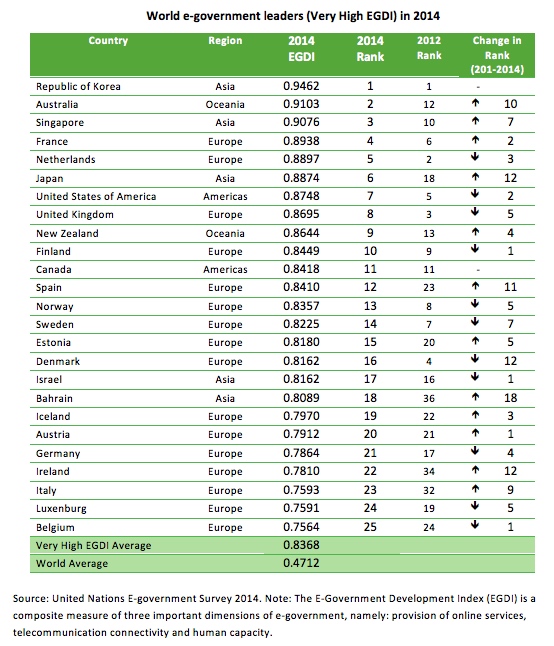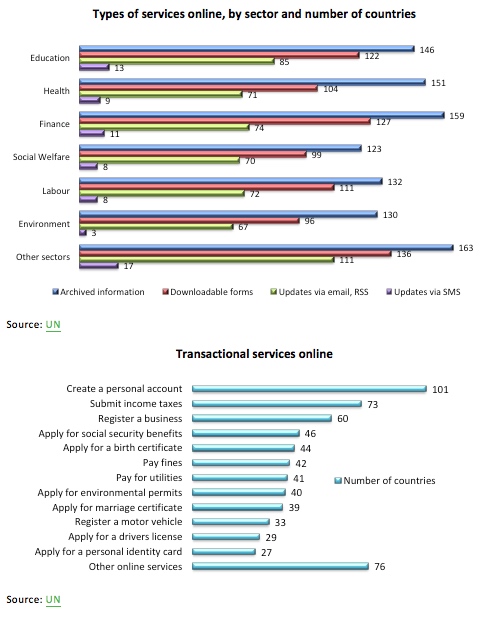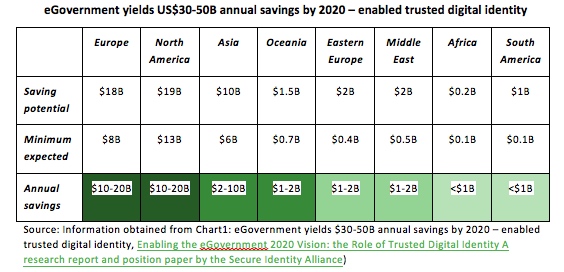August 2015: In our June and July briefings took the perspectives of businesses and consumers respectively in exploring the opportunities and challenges of navigating tomorrow’s digital landscape. This third and last part in our trilogy focuses on what digitalization and digital transformation means for governments.
Ongoing technology changes are yielding productivity gains and driving innovation in the private sector, enhancing value and choice for the consumer. These consumers are citizens too – and as they become more digitally proficient and aware, it is critical that governments respond to the growing demand for innovative, convenient and cost-effective public services. Heavy, and often costly, government organizations need a new approach to delivering their services in a connected world, services that not only offer time and cost-saving alternatives to citizens but also make the public sector more efficient and agile. Digital technologies are a transformational force which if harnessed effectively can provide “game-changing” opportunities for governments. At the same, digitalization brings with it significant challenges that may make governments more vulnerable and complex to manage, whether guarding against an exponentially rising array of cyber attacks or developing new legislation fit for a connected world where borders are increasingly irrelevant and the ownership of personal digital information is unclear.
The digitalization processes of government vary both in their objectives and their levels of sophistication. The OECD suggests that some governments can be categorized as E-Governments, which refers to the use by these governments of information and communication technologies (ICTs), and particularly the internet, as tools to achieve better government. Digital Governments, on the other hand, are defined by their use of digital technologies as an integrated part of modernization strategies to create public value. They rely on a digital government ecosystem comprised of government actors, non-governmental organizations, businesses, citizens’ associations and individuals which supports the production of and access to data, services and content through interactions with the government. (Source: OECD).
As of 2014, all 193 UN member states had some form of online presence, as compared to 18 countries without online presence in 2003 and 3 countries in 2012. While the more developed nations, as expected, are relatively well advanced in adopting digitalization in the public sector, many countries still have a way to go; in some cases in less developed nations, a long way.

The transition from traditional government to e-government is a long-term and challenging process, but offers significant potential value. Let’s take a look at what this means when implementing an e-government strategy.
The challenges of digitalizing government services
The public sector, no matter where in the world, is not exactly known as being an early adopter when it is comes to new technologies and business models. While governments will, eventually, adapt to “the new world” they tend to do it in their own good time – and overcoming bureaucratic hurdles to change can be a massive challenge that takes many years. Becoming a true digital government requires change, not only to IT systems but also to processes and organizational culture. Add to this the challenge of the digital divide among citizens as well as underdeveloped infrastructure in many nations. An increasing number of people may be going digital, but lack of access to connected devices as well as poor digital literacy and capabilities are challenges that must be work into the digitalization strategies of government services.
Trends in action:
The digital divide: The digital divide stems from a combination of lack of physical access to technologies, and to disparities in levels of education and skills needed to use the technology. Low income has been found to be the single most important barrier to acquiring technology. However, prohibitive costs to access the internet also prevent many people from going online. One might think the digital divide is limited to developing countries, but that is not the case. In the U.K for instance, one in eight British adults have never been online, some because they “can’t” and some because they “won’t.” To succeed in delivering digitized government services it is critical to have a strategy that includes both digital “haves” and “have nots.” In the U.K, the Government Digital Service (GDS) is working to include both groups. In Brazil, the government and the NGO Rede Marista de Solidariedade have teamed up to bridge the digital gap in Brazil by promoting universal access to the web. (Sources: The Telegraph, UN)
The transformation challenge: A joint study by McKinsey and Oxford University has found that public sector IT projects requiring business change were six times more likely to experience cost overruns and 20% more likely to run over schedule than similar projects in the private sector. Digital transformation in the public sector is simply not as easy as in the private sector. The public sector operates in a completely different context, dealing with multiple agencies, a range of organizational mandates and constituencies, longer appropriations timelines and the challenge of maintaining strategic continuity even as political administrations change. This translates into digital transformation projects that are large-scale and complex; consequently many transformational efforts fall short of their promises.
Look out for:
The cyber-security challenge: Cyber crime is increasingly dangerous for governments, businesses and ordinary people alike. When the malware Flame was discovered in 2012, the UN urged co-operation and peaceful resolutions among countries to prevent a global cyber war. Since then the world has seen numerous cyber attacks. In Spring 2015 the U.S. government was hit by a massive data breach involving information on millions of public sector workers, potentially affecting all U.S. federal agencies. It is believed that Chinese hackers were behind the hack. (Source: BBC). The increasing uses of ICT in the world’s governments ramp up the risks of cyber warfare, something that could also have negative consequences for international stability and security. Governments around world face a critical need to ensure that the handling of their own and citizens’ data is secure in all operations and across all departments.
Becoming the disruptor instead of the disrupted: Governments always seem to be one step behind when it comes to implementing and using technology: Clear goals for digital strategies at all levels in the public sector are necessary to ensure and design governance structures that are up to date with the latest technologies. New business models, e.g. Uber and Airbnd, are already finding ways to shrewdly work around existing government legislation, creating significant challenges as governments struggle to get to grips with these innovations. Instead of being an adopter in a digital world governments must ensure that they become the driver of innovation, e.g. by being one step ahead technology-wise and/or by partnering with new innovative businesses. (Source: Accenture)
Creating value through digital government
Many governments around the world have started digitalizing their services in a range of sectors.

As we have already noted, it’s not easy, but in many countries it has already delivered significant savings as well more convenient ways to communicate and interact with the government. Digitalized and innovative governments provide huge opportunities to create more efficient and sustainable development for nations – to benefit the environment and sustainability, stimulate economic growth, promote social inclusion, and improve healthcare and education.
Trends in action:
Positive impact of digitalization: Accenture reveals in the newly released report Digital at Depth: Digital Technologies at the Heart of Public Service Transformation that digital transformation of government services can have a positive impact on a country’s economy, competitiveness, innovation and its citizens. It suggests that a digitally enabled government could reduce back-office costs by up to 45%, while a 1% increase in digitalization can mean a 0.5% gain in gross domestic product and a 1.9% gain in international trade. A 10% increase in digitalization could translate to a 0.86% drop in a country’s unemployment rate. (Source: ITP.net). The table below offers findings from another report on the potential cost savings by enabling a trusted digital identity for citizens.

Look out for:
M-government for the vulnerable and poor: A number of countriesare using mobile government services to reach citizens, both in developed and developing countries. The m-government tool is particularly valuable in developing countries where internet penetration is low due to lack of infrastructure but where mobile connectivity and penetration is high. However, it should not be seen as a replacement of e-government/digital governments but as a part of it. Japan is using mobile services to deliver emergency information from local governments and reports from its disaster systems. In India the mobile government application Himmat for women demonstrates the Indian government’s commitment to ensuring women’s safety, helping victims to get immediate police assistance in the event of emergency. (Source: m-GovWorld) Also in India, GE used the Machine Learning software Corvix – a branch of artificial intelligence that relies heavily on probability statistics – to help the government determine where it should build medical facilities for 80m people. (Source: The Economist)
Multichannel service delivery channels with a personalized touch: The delivery channel for a government service can add or subtract value to a person’s user experience, impacting the user’s perception of and confidence in government services. In a world demanding personalization and customization it pays to have multiple service delivery channels that make it easy to access individual services on the move. The channels of delivery could be, e.g. face-to-face, email, SMS, mobile apps, social, media and public kiosks. The key is that governments offer diversity in delivery channels to drive citizen engagement. For example, Sweden has implemented a national programme called SMSlivräddare, or SMSLifesaver, where trained citizen volunteers can enroll to receive an SMS text when there is a heart attack victim nearby, allowing them to offer cardiopulmonary resuscitation (CPR). (Source: UN)
Moving from ambition to action
A downside of having regularly elected governments is that policies can change dramatically every three to five years, which means the transition towards digital government – already a long-term project – may be hijacked by short-term budgetary and political pressures. Many of the world’s governments have ambitious digital visions but getting all the stakeholders, including opposition parties, to agree on a digital roadmap whose course will not be changed by subsequent electoral shifts is tough. It’s even tougher to move from ambition to execution when massive amounts of bureaucracy that have vested interests in the status quo need to change, sometimes dramatically. What we can learn from the more digitally forward-thinking governments in different regions about seizing opportunities and overcoming barriers to change?
Europe
Europe 2020 Strategy is the European Commission’s digital agenda, setting objectives and proposing how to better exploit the potential of ICT to foster innovation, economic growth and progress in the European Union by 2020. It consists of seven pillars. One priority is ICT-enabled benefits for society which include e-government. The eGovernment Action Plan identifies four priorities, namely empowerment of citizens and businesses, further construction of Europe’s digital single market, efficiency and effectiveness of government, and implementation of the above through key enablers and the necessary legal and technical preconditions including interoperability. (Source: UN)
Denmark: Is already providing citizens, businesses, and employees with access to personalized content based on their specific circumstances, needs, and preferences. For instance, Denmark’s MyPage provides Danes with a clear view of all the personal information held about them by public authorities in one personal “online drawer” and enables them to perform transactions in a secure environment via a secure letterbox. By 2015, Danish public services expect to send 80% of all correspondence to citizens in digital form. They also expect that 80% of all applications and correspondence from citizens will be in digital form. It will save billions of Danish kroner on administration throughout the public sector. (Source: Digitaliseringsstyrelsen)
Estonia: 1.3 million residents can use electronic identification cards to vote, pay taxes, and access more than 160 services online, from unemployment benefits to property registration. Estonia has put a microchip in the traditionalID cards issued to every citizen for identification and domestic travel inside the EU. The chip carries two certificates: one for legal signatures and the other for authentication when using a website or service that recognizes the government’s identification system (e.g. online banking). Every person over 15 is required to have an ID card, and there are now over 1.2 million active cards, close to 100% penetration of the population. In doing so, Estonia has reinvented a key component of its infrastructure and become a success story for digitized governments. (Source: The Atlantic)
Africa
There is no overall digital strategy for the disparate nations of the African continent. However, many governments are working on mobile government initiatives and social media strategies. Despite the many digital initiatives, it remains critical that African governments play a greater role in promoting connectivity and reducing the digital divide by, e.g. reducing access costs, and building infrastructure. Examples of country initiatives include:
Morocco: As part of the government’s effort to bring e-services to its citizens and include them in the decision making process, the Moroccan government has developed an e-consultation platform through the website of the Secretariat General du Gouvernement, where citizens can access legislative texts online, read and download them, and post their comments and concerns. In this way, the government offers a transparent, inclusive and easy channel through which citizens can make their voices heard, enriching democratic governance processes. The government also presents its responses to citizens’ comments, showing that they track the concerns and remarks of citizens, and take them into consideration. (Source: UN)
Kenya: Supported by the World Bank under the Transparency Communication Infrastructure Project (TCIP), the Kenyan government has started a connectivity and e-service delivery project. The Government has identified ICT as key to the provision of efficient and cost-effective services to citizens, businesses and other public agencies. The Kenya Vision 2030 identifies ICT as a key pillar to growth and prosperity, e.g. the E-Government initiative saves citizen’s travel time to government offices and allows 24/7 access to services. Commendable efforts have been made on e-applications, capacity building and infrastructure development. (Source: Softkenya)
Americas and Oceania
South and Central America as well as the Caribbean are still struggling with infrastructure problems, broadband quality and ensuring sustainable growth. Despite the fact that the regions countries are paying more attention to the benefits of implementing e-governments they are facing a great deal of challenges regarding public online service delivery. North America and Oceania, on the other hand, have taken important steps to drive innovation and sustainable growth through e-government strategies. Examples of country initiatives include:
Columbia: For Colombia, the e-government strategy is seen as an effective means to build a more efficient, transparent and participatory government where high quality services are provided, through the use of ICT. It uses a citizen-centered strategy that has been implemented in five phases: information, interaction, transaction, transformation and e-democracy. Some important results to date include: the provision of procedures and services through electronic media, the creation of scenarios for participation, and the improvement of the quality of information in public agencies (Source: Action plan of the government of Columbia . Open government partnership)
United States: The US has put a strong digital government plan in place and is investing heavily in advanced digitalization of government services to drive cost efficiency and digital administration. The US Digital Government Strategy sets out to accomplish three things:
- Enable the American people and an increasingly mobile workforce to access high-quality digital government information and services anywhere, anytime, on any device.
- Ensure that as the government adjusts to this new digital world, we seize the opportunity to procure and manage devices, applications, and data in smart, secure and affordable ways.
- Unlock the power of government data to spur innovation across our Nation and improve the quality of services for the American people.
Asia and the Middle East
Asia, including the Middle East, is the largest and most populous continent in the world. In terms of digitalization, while countries such as Singapore and South Korea have a high level of online presence, others like Burma and Pakistan lag far behind. Examples of country initiatives include:
Sri Lanka: Sri Lanka’s e-government strategy aims to include and offer services to all segments of the population, regardless of their IT literacy levels or access to the internet. With mobile penetration rates in the country exceeding 100%, even the poorest people having cell phones – so the government offers many m-government services.The Sri Lankan government has also made a substantial effort to develop its online portal, which offers A-Z government web indexes, 108 e-services for citizens, 51 e-services for businesses, and 10 non-residence related e-services. The portal also offers extensive mobile and SMS services, an e-participation portal, government forms easily accessible online, a developed open data portal with data available in various formats, as well as a whole-of-government strategy. (Source: UN)
Singapore: TheSingapore 2015 e-government plan is built on the vision to be a collaborative government that co-creates and connects better with its citizens. The country has programs for its citizens such as data.gov.sg that provides easy access to publicly available government datasets; mGov@SG that allows individuals and businesses to easily search, identify and access mobile services provided by the government; OneInbox that allows individuals and businesses to receive electronic correspondence from the government in place of hard copies; and a website transformation strategy that brings sustainable improvements in the quality of government websites. The government has also implemented digital initiatives for public officers such as Cloud computing for government, Workplace of the future and Cube, a collaborative social networking platform for public workers to exchange ideas, share knowledge and work together in a virtual government space. (Source: Accenture)
United Arab Emirates: UAE already has advanced ICT infrastructure as well as high internet and mobile penetration. In 2008, The Abu Dhabi Systems & Information Centre (ADSIC) was established to optimize e-Government services in the country. ADSIC’s shared government initiatives include: the Abu Dhabi Government Contact Centre, e-Citizen Program, Abu Dhabi Spatial Data Infrastructure, Abu Dhabi Portal, CityGuard Application, Jobs Abu Dhabi and the government correspondence management system. Recently, a new strategy ‘Towards a Digital Abu Dhabi’ maps out the digital transformation of Government services and shared ICT infrastructure, primarily focusing various m-Government services. (Source: ITP.net)
In September: Look out for trends in action on climate change – with an all new briefing design!




